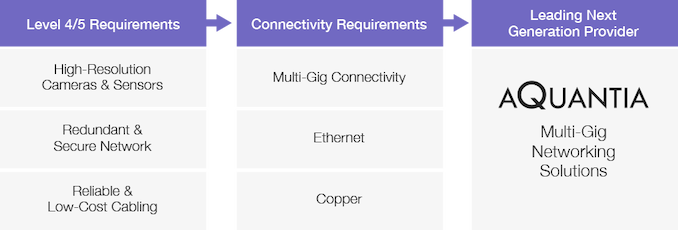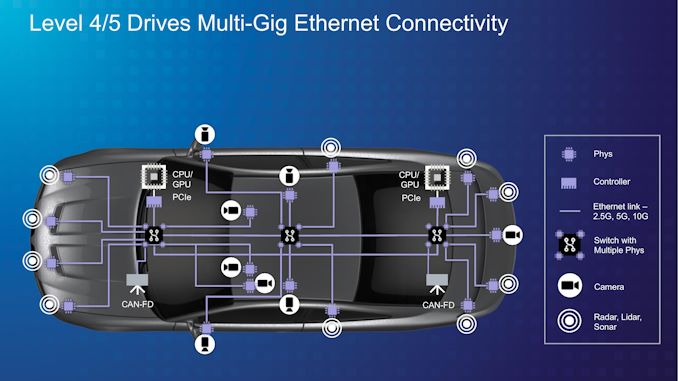Marvell to Acquire Aquantia, Eying Automotive Networking Market
by Anton Shilov on May 6, 2019 2:30 PM EST- Posted in
- Networking
- Marvell
- Aquantia
- Automotive

Marvell on Monday announced that it had reached an agreement to buy the networking specialist firm Aquantia for $452 million. The acquisition will allow Marvell to significantly augment their current networking capabilities, with the company intending to use Aquantia's technology in future PC, enterprise, and especially in-vehicle applications.
Under the terms of the deal, Marvell will pay Aquantia shareholders $13.25 per share in cash, bringing the total value of the deal to $452 million. The transaction has already been approved by board of directors of both companies, and subject to regulatory approval, is expected to close by the end of calendar year 2019.
Aquantia for its part is best known for their Multi-Gig (2.5G/5G/10G) Ethernet controllers for a variety of markets, including PC, datacenter, and automotive. In fact it's this latter market that seems to have caught Marvell's eye, as the bulk of Marvell's official press release is dedicated to talking about automotive applications. Marvell in particular is looking to grow their high-speed in-car networking product portfolio, with Aquantia's multi-gig technology helping Marvell to deliver products with enough bandwidth for level 4 and level 5 autonomous driving systems. Fittingly, on a broader basis Marvell is expecting the market for in-vehicle networking to grow significantly over the coming years, citing one study that expects over 350 million ports by 2022.
Meanwhile, commenting on the buyout from their end, Aquantia's CEO and chairman Faraj Aalaei had this to say:
"Marvell and Aquantia share a vision where the network – whether in an autonomous vehicle, an enterprise application or in cloud infrastructure – can seamlessly power the data economy. This is a fantastic opportunity as our customers will benefit from Marvell's global scale and expanding footprint in Multi-Gig network applications."
It's also noteworthy here that along with Aquantia's technology, Marvell will get to acquire Aquantia's business connections. This includes Aquantia’s collaboration with NVIDIA for their Xavier and Pegasus Drive AGX systems, which in turn are expected to be adopted by a number of auto makers. So this potentially opens the door to a much larger market for Marvell.
Overall the buyout of Aquantia is the latest high-profile acquisition for Marvell. The company previously picked up CPU and SoC specialist Cavium in late 2017, using their technology to improve Marvell's own SoCs. With the addition of Aquantia, Marvell has developed a rather deep portfolio of products and IP that can be used by a variety of applications, from embedded to automotive to the datacenter.
As for Aquantia, it's worth noting that the sale comes at a time where the company has been struggling to grow out of startup mode and become profitable. Also released today were the company's Q1'19 earnings, where Aquantia lost $13M on $17M in revenue. These sorts of acquisitions are negotiated over many months, so the Marvell buyout shouldn't be a direct reaction to their Q1 earnings. But on the whole Aquantia hasn't been in the black yet, making an acquisition one way to stabilize the core business.
Related Reading:
- Marvell Completes Acquisition of Cavium, Gets CPU, Networking & Security Assets
- Aquantia’s Gamer Edition AQtion AQN-107 10 GbE NIC Available
- Dell Announces Latest Precision Entry Level Workstations: Powerful 1U Rack and SFF Desktops
Source: Marvell












21 Comments
View All Comments
Kevin G - Monday, May 6, 2019 - link
The automotive market is less about raw bandwidth and more about determinism in such a scenario. Being able to truly dictate bandwidth usage with predictable latency is a key capability of the Aquantia chips. For automotive this is critical considering the number of switches just in the topology outlined in the article.Ideally you'd want to have all the devices going to a pair of redundant switches with each having their own dedicated runs. I presume that the automotive industry has some unique requirements for redundancy due to things like crashing and still keeping the maximum number of sensors operational.
Lord of the Bored - Monday, May 6, 2019 - link
Aaaaaand cheap multi-gigabit ethernet just died. Yay.Ian Cutress - Monday, May 6, 2019 - link
https://www.anandtech.com/show/13428/realtek-has-2...DigitalFreak - Monday, May 6, 2019 - link
No 5 or 10gig support.Lord of the Bored - Tuesday, May 7, 2019 - link
"Things we missed" is an appropriate headline, it seems.I stand pleasantly corrected.
Kevin G - Tuesday, May 7, 2019 - link
2.5 Gbit speeds are pretty much a freebie since the change between 2.5 and 1 Gbit is expanded symbol space at the same line rate.mariush - Monday, May 6, 2019 - link
Shame it wasn't bought by AMD. nVidia just acquired Mellanox.Would have been cool to have 10g or 5g in the chipsets or have AMD push 5g/10g by discounting ethernet chips when bundled with chipsets or something like that.
Kevin G - Tuesday, May 7, 2019 - link
Considering the changes to bring 2.5 Gbit to market, I see it becoming widespread rather quickly. 10 Gbit is already a well understood and deployed widely at the highend (servers, workstations etc.).The odd ball is the 5 Gbit rate which recommends CAT6 over CAT5e cabling for any significant distances and increases the line rate over 1/2.5 Gbit. At this juncture, it'd make sense to simply add 10 Gbit support alongside the 5 Gbit rates from a NIC standpoint.
The real question is when we'll see inexpensive 2.5/5 Gbit capable switches for consumers. 10 Gbit units are just now trickling into the highend consumer side after being common place in the datacenter but carry a price premium. The hope is that 2.5 Gbit will quickly supplant 1 Gbit at the same price.
tezcan - Saturday, May 11, 2019 - link
Mellanox is a system manufacturer- they buy chips from Aquantia (an IC manufacturer).basroil - Monday, May 6, 2019 - link
Ethernet? Count me out, they need ethercat at minimum